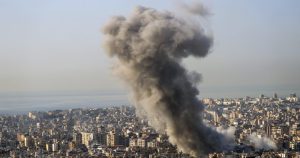Jackie Wullschläger’s personal pick of Venice’s Accademia Gallery
This article is part of a new guide to Venice from FT Globetrotter
The Accademia stands on the Grand Canal in the former Santa Maria della Carità church, monastery and scuola grande. The earliest building is 12th century, and later additions include a Palladian wing and neoclassical renovations. A palimpsest of Venetian architectural history, the site corresponds sympathetically to its spectacular collection of Veneto art from medieval times to the 1800s: a vivid unfolding of the distinctive, intoxicating qualities — light effects, sumptuous colour — connecting the Venetian school across centuries, Bassano to Bellotto, Cima to Canaletto. Above all, to see at home the painters from the golden age of the Venetian High Renaissance — Giorgione, Titian, Veronese, Tintoretto — who transformed art history everywhere is one of Europe’s great museum experiences.

1. ‘Madonna and Child and Saints Catherine and Mary Magdalene’, 1490, by Giovanni Bellini

Bellini’s serene, solemn, warmly human madonnas defined the iconography of the subject in devotional painting for half a century. The Accademia has a whole gallery of fine examples, led by the “sacred conversation” between the Virgin and St Catherine and Mary Magdalene. Bellini’s characteristic soft light spreads across diaphanous flesh, jewels, rich garments; the figures against the dark background seem also to glow from within, acquiring a numinous presence. First Floor, Gallery Five
2. ‘The Tempest’, c1504, by Giorgione

A lightning bolt splits a turquoise sky over a distant town, wind whips the trees, yet a strange stillness pervades the scene of a storm about to break. The melancholy man and woman in the foreground are enigmatic, and Giorgione himself was an elusive figure: apprenticed to Bellini, he developed a fresh, lyrical approach with atmospheric effects of light and shadow, unifying figures and landscape, then died in his early 30s, leaving few securely attributed works but an enormous impact, especially on Titian. The mysterious “Tempest”, one of the first landscape paintings in western art, is his masterpiece. First Floor, Gallery Eight
3. ‘The Archangel Raphael and Tobias’, 1508, by Titian

Titian’s imaginative strength and compositional boldness burst forth in this captivating painting, about starting out on life’s journey. He brings humour and humanity to the tale of Tobias — here a young child — trotting alongside his new companion, looking up at him with confident trust, grasping him tightly with one hand, with the other dragging along his big fish. Rhythms of gestures, rippling tunics and tender glances are exquisite, and already Titian, aged 20, pervades everything with the blended hues of a twilit landscape. First Floor, Gallery Eight
4. ‘Portrait of a Gentleman in his Study’, c1527, by Lorenzo Lotto

Lotto’s angular, introspective, long-fingered youth, in relaxed pose, languidly turning the pages of a book, grabs our attention from a small gallery along the Palladian loggia. It’s a fantastically idiosyncratic portrait, in large and unusual horizontal format, with every object — drooping ruffled silk cuffs, lizard crawling across a cascading shawl, flurry of rose petals, crumpling letter — imbued with its own energy, while all imply the gilded lethargy of their owner. First Floor, Gallery Nine
5. Palazzo Corner Spinelli ceiling, 1542, by Giorgio Vasari

Vasari is the Accademia’s Florentine interloper: its latest acquisition, unveiled in August 2024 following decades of detective work, is the shimmering panels of figures representing the virtues and, piquantly, their opposites, commissioned for a Grand Canal palazzo’s coffered ceiling. Dispersed in the 18th century, they are reassembled in an immersive installation revealing a splendidly cohesive composition of foreshortened figures against lapis lazuli-streaked clouds, as if the ceiling opens to the sky. The last contrasting pair reunited were “Hope”, owned by the late publisher George Weidenfeld, and “The Suicide of Judas”. First Floor, Gallery 13a
6. ‘Miracle of the Slave’, 1548, by Tintoretto

Tintoretto wanted to combine “the drawing of Michelangelo and the colour of Titian”. The influence of both shines in the gesturing interlocking bodies and clear sonorous tones of his drama where St Mark, Venice’s patron saint, suddenly appears, plunging head first from the sky, to save a Christian captive from torture. Tintoretto made his reputation for chiaroscuro theatricality, dash and fluency — “tutto spirito e tutto prontezza” — with this dynamic painting. First Floor, Gallery 11
7. ‘Feast in the House of Levi’, 1573, by Veronese

For his teeming depiction of a Venetian banquet, originally designated a “Last Supper” and at 13 metres wide among the largest Renaissance pictures, Veronese faced the Inquisition, accused of irreverence in placing “buffoons, drunken Germans, dwarfs and other such scurrilities” in a momentous religious scene. His defence — “if in a painting there is space left over, I fill it with figures, per ornamenti, come si fa” (for ornament, as one does) — expresses his credo of artistic freedom and the drive for opulent decorativeness that make his narratives endlessly absorbing. First Floor, Gallery 10
8. ‘Pietà’, 1576, by Titian

Intended for his own tomb, Titian’s final painting includes two self-portraits: the bearded old man holding the dead Christ’s hand and, engraved on the tablet beneath the stone lion, the artist and his son Orazio praying for delivery from the plague. It killed them both that year, when it raged in Venice. The air is thick with dread and death in the painting too, made in Titian’s loose late manner, dark colours quickly applied, pierced by quivering silvery light. First Floor, Gallery 11
9. ‘The Transport of the Holy House of Loreto’, 1742, by Giambattista Tiepolo

An Austrian bomb destined for Venice’s train station in 1915 hit instead Santa Maria di Nazareth next door, destroying Tiepolo’s ceiling. The Accademia has his lively oil sketch for the fresco — angel and cherubs surging around Mary as her Nazareth home miraculously moves to the pilgrim site Loreto — and some trompe l’oeil fragments: prophets declaiming in the spandrels, spectators ogling from a balcony. Don’t miss these hanging from the upper corners of grandiose Gallery 11; glance above its monumental paintings (Titian, Tintoretto), and the characters playfully return our gaze. Ground Floor, Gallery Two (sketch); First Floor, Gallery 11 (fragments)
10. ‘St Mark’s Basin with the Island of San Giorgio and the Giudecca’, c1774, by Francesco Guardi

Although Palladio’s St Giorgio Maggiore church gleams across the water, Guardi’s real subject is Venice’s vibrant atmosphere, dazzling canal reflections and ceaseless movement of boats on the lagoon, captured in flickering, agitated brushwork, dabs, flecks, always a light, feathery touch. Guardi was the Venetian Republic’s last great artist; his fugitive, unstable scenes perhaps suggest the city’s political decline but, anticipating Impressionism in his fleeting effects, Guardi also looked forward — a link between Venetian tradition and European modernity.
Ground Floor, Gallery Eight
Gallerie dell’Accademia, Calle della Carità, 1050, 30123 Venice; gallerieaccademia.it
Have you visited the Accademia Gallery in Venice, and if so, what were your favourite works? Tell us in the comments below. And follow FT Globetrotter on Instagram at @FTGlobetrotter
Cities with the FT

FT Globetrotter, our insider guides to some of the world’s greatest cities, offers expert advice on eating and drinking, exercise, art and culture — and much more
Find us in Venice, Paris, Rome, London, Tokyo, New York, Frankfurt, Singapore, Hong Kong, Miami, Toronto, Madrid, Melbourne, Copenhagen, Zürich, Milan, Vancouver and Edinburgh
#Jackie #Wullschlägers #personal #pick #Venices #Accademia #Gallery







